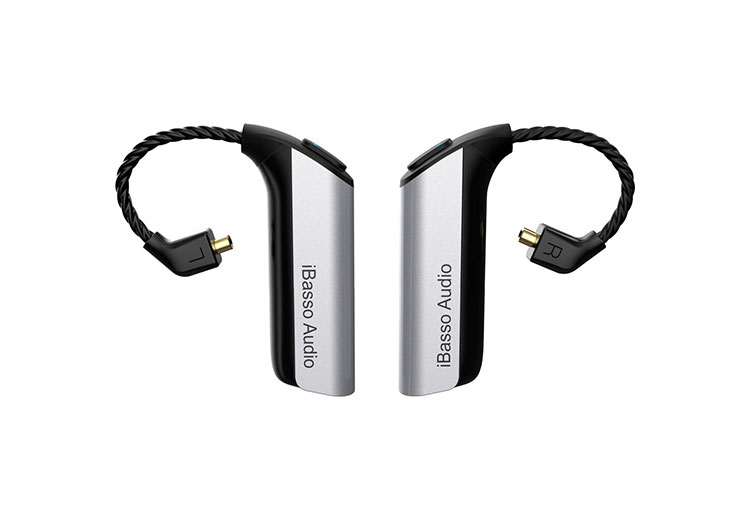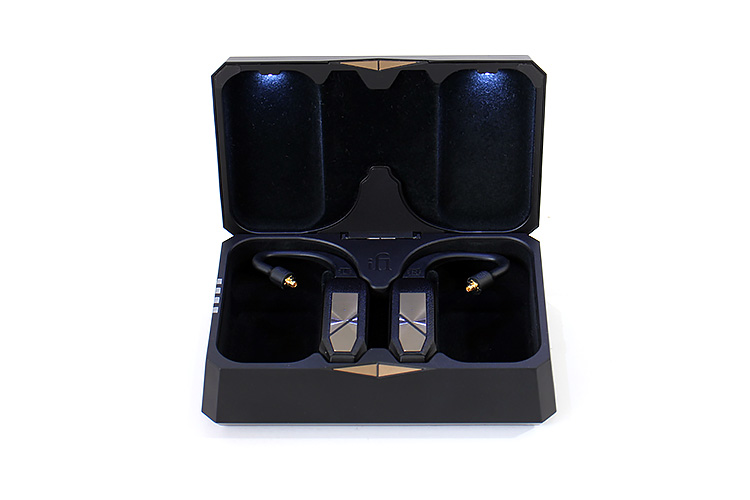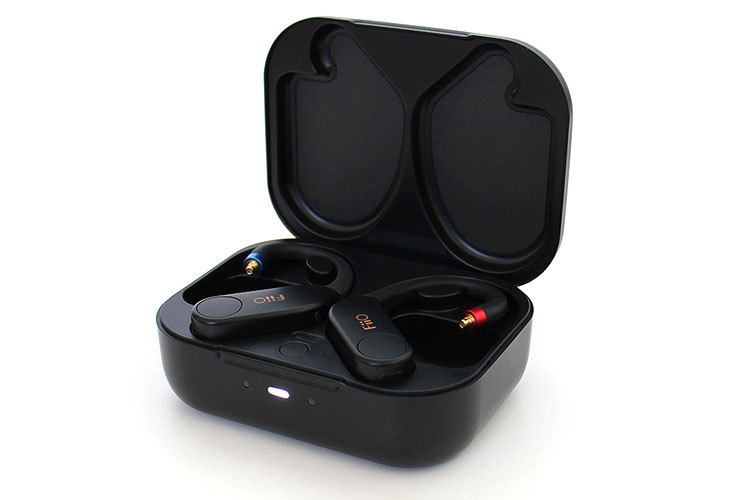Partnered Bundles
iFi Audio also offers the GO pod bundled with many popular high-end IEMs and is offering them at reduced costs compared to purchasing each item separately. It’s something to consider.
As of today, iFi Audio offers six models to choose from. I received my set with the Meze Audio RAI Penta, which is a well-balanced, beautifully constructed IEM. They emit a realistic tonality that’s generous with micro-detail production and demonstrate great bi-directional frequency extension capacity.
The GO pod brings forth an uncanny resemblance in sound quality to this IEM that rivals a wired setup and perhaps one could say that a small portion of the transient response is absent. But overall, I like what I hear.
Sound Impressions
These impressions were completed using a mix of the bundled Meze Audio RAI Penta and the HIFIMAN Svanar flagship IEMs.
Summary
I ran the iFi Audio GO pod on LDAC and two things were evident, these dongles can reach loud volume levels with no distortion and the staging is excellent for a Bluetooth wearable dongle or any Bluetooth device for that matter.
To generalize the iFi Audio GO pod sound signature, it seems to be neutral-driven and well-extended both ways. The bass response is neutral, and the mids are smoothly represented with an absence of harshness, with an additional hint of warmth. The high frequencies put one in disbelief that this is a Bluetooth device.
Noise levels seem to be excellent but it’s probably a product of the GO pod’s impedance-matching amplifier which breaks down power into 4 impedance categories. So, the GO pod always remains silent because it technically has those 4 gain settings and will more than likely choose the lowest usable one.
But that doesn’t stop the GO pod from reaching high levels of volume and they also demonstrate an almost bottomless power reserve if you go by the volume level. Oh, by the way, the built-in volume control is an analog volume according to iFi but there’s no channel imbalance.
Staging and Dynamics
One of the drawbacks of current Bluetooth chipsets is that they lose some coherence and definition in positioning as far as staging and at times things can get conglomerated but not with the iFi Audio GO pod. That’s aside from the high frequencies dropping their max upper frequency and losing extension reach.
Yea, perhaps you’ll notice a small loss of pinpoint information and the overall aura of elements will lose some of the outer shell definition but the positioning precision is there and so is the imaging which can produce a smooth pan.
Wireless Performance
Stability and Range
I didn’t experience any dropouts or disconnections while using the iFi Audio GO pod and walking around the house. Perhaps the only area I couldn’t enter was a rear bathroom that puts the GO pod far away and around a corner from the source.
I mostly used the FiiO BTA30 which at times produces quirks that other devices don’t, but not with the GO pod. To its credit, you can’t go wrong with the device since it’s able to transmit and receive a BT signal and it locks onto LDAC without a hitch.
My Google Pixel worked as expected and the LDAC feature was picked up right away as the preferred codec. This mobile device runs LineageOS. I installed it since I read somewhere it has a better USB output plus it enables all the BT modern-day codecs.
Latency
There is a low latency mode within the Gaia app that works on the iFi Audio GO pod but most times the system will kick into a low latency mode anyway unless you’re using something like the FiiO BTA30 that lets you select what mode to specifically run and give priority to.
If you run LL codec latency will be of no issue since I noticed a well-synched audio while watching movies playing on my home desktop custom PC using VLC. On other codecs, there was an acceptable but noticeable latency delay of approximately 0.3 seconds from the GO pod drivers.
Select Comparisons
FiiO UTWS5
Technical
I bring great news in case you didn’t know. FiiO just released a firmware for the UTWS5, version 1.73, that throws LDAC capability into the mix but it will only work with a list of phones that use specific Qualcomm processors.
Including LDAC capabilities on the UTWS5 completes it. You were almost the first to have it, almost. I still use them occasionally and probably will keep them because they sound great and work in a no-fuss manner.
Unfortunately, although my phone is a Google Pixel with a Qualcomm Octa-core processor, it just doesn’t pick up LDAC and maxes out on aptX HD which plays at 576kbps rates. But my Pixel does switch to LDAC with all the rest of the devices I have that transmit LDAC so I don’t know what to say there.
On a very positive note, the FiiO control app is one of the best around and better looking than the Gaia Go pod app. Since FiiO started introducing new firmware updates they’ve opened up every feature, including the Equalizer to work with the UTWS5. There’s also an abundance of DAC filters and other features to choose from.
Design
The cradle itself is around half the size of the GO pod cradle and only musters up half of the battery capacity at 800mAh. It’s still good for over three full charges and each full charge gives the user approximately 7 hours on each run.
One positive aspect is that the UTWS5 cradle is way more pocket-friendly and it also has rounded corners. It’s not small by any means but it should fit into most large pockets. So, that counterbalances the 10-hour total playtime difference.
The ear hooks are not removable and come preinstalled with one termination. So, you have to order the correct one for your IEM. You can always use adapters but I prefer fewer connection points and always try to avoid multiple adapter scenarios.
Construction materials are polymer over polymer with a single USB-C port behind the cradle, below the hinge. The innards are not lined with anything but the material doesn’t seem too abrasive and I wouldn’t worry too much about scratching up my expensive IEMs inside the cradle.
Performance
I would check that compatibility list to see if your particular mobile device will run the LDAC with the UTWS5. Because if you find your device in that list then the better bargain would surely be the UTWS5.
But even when you compare these two models in aptX HD mode, the GO pod gives you an edge in sound quality which is quite large. They have more power, better imaging, and display an absence of hissing.
But overall, the FiiO UTWS5 gives you a lot of quality sound and functionality for what they’re going for today and if you’re strapped for cash then I wouldn’t hesitate to recommend these.

iBasso CF01
$149.00
Technical
iBasso does many things right and might even be on top when it comes to certain types of gear genres. Most will think of their excellent DAPs but I also like their IT07 multi-driver IEMs. They sound expensive and give you that wow factor the first time you wear them.
But what about their version of the hook-style Bluetooth IEM dongle? The only model they have released so far is the CF01 which I liked for many reasons.
First, the construction quality is excellent. Second, the sound quality is also very good but compared to the Go pod it is more limited in codec choices and it seems iBasso is not giving it future support. So, I’m waiting for that moment for iBasso to come out with a revision sometime soon. Hopefully.
Design
When you hold the CF01 for the first time they give you a reassuring sense of quality and that they’re not going to break down any time soon. The tough ear hook takes some abuse but some would prefer the rubber coating of the others even though they seem to be stronger and simultaneously slimmer.
The dongles have an aluminum outer shield that I assumed at first would affect the signal quality but it seems their antenna system was placed in a logical place since they rate excellent far as signal stability.
The touch controls also work well on this set. They also have a good amplification section but compared to the Go pod they lack an app plus they only come with an MMCX terminated ear hook which of course is fixed and not swappable.
Performance
The iBasso certainly has a powerful output section that is less restricted compared to the FiiO UTWS5 and can reach much higher volume levels but some have complained of a slight amount of hiss present when using some very highly efficient IEMs.
It seems they’re a basic set with good known hardware but lack any high-tech configurations or impedance matching that I know of. They’re full all out all the time and on some occasions I prefer that over a safe tuning that can’t reach adequate volume levels.
The iBasso does have a high level of dynamic responsiveness and demonstrates an ability in the bass department and the midrange alike to sound realistic and true-toned but the high frequencies could be cleaner compared to the GO pod particularly. Perhaps it’s due to a lack of HQ BT codec capability.
Our Verdict
The iFi Audio Go pod certainly took pole position in the ear hook Bluetooth dongle segment. It has one of the best sonic performances, stability, and convenience I have heard and tested to date. You can consider the cavernous battery as the frosting on the cake.
The only caveat is the large size of the cradle which makes it difficult, impractical, or almost impossible to pocket carry and some might cringe on initially viewing the price tag.
But trust me, they’re worth every penny. Not only for the convenience of going wireless or for the convenience of being able to use the GO pod with multiple IEMs simultaneously but for the sheer sound quality that almost rivals a wired solution, particularly on LDAC.
iFi Audio GO pod Technical Specifications
- Bluetooth version: Bluetooth 5.2TM
- Bluetooth Codecs: LDAC, LHDC/HWA, aptX Adaptive, aptX HD, aptX LL, aptX, AAC, SBC
- Bluetooth chipset: Qualcomm QCC 5100 Series
- Auto impedance detection: 16Ω/32Ω/64Ω/300Ω
- SNR: 32Ω ≥129dB (A) / 300Ω ≥132dB (A)
- THD+N: ≤0.002% (1kHz/32Ω)
- Frequency Response: 10-20kHz(-3dB) LDAC
- Battery:GO pod 180mAh + Charging case 1500mAh
- Power System: 5V/1A or 5V/2A Qi-certified charger
- Working hours: GO pod ~7h + Charging case ~30h
- SNR: 32Ω ≥129dB (A) / 300Ω ≥132dB (A)
- Weight: GO pod 12g (0.42 oz) / Case 126g (4.44 oz)
- Dimensions: GO pod – 43.5 x 16.4 x 9.5 mm (1.7″ x 0.6″ x 0.4″) / Charging case – 116x76x38.5mm(4.6″x3″x1.5″)





